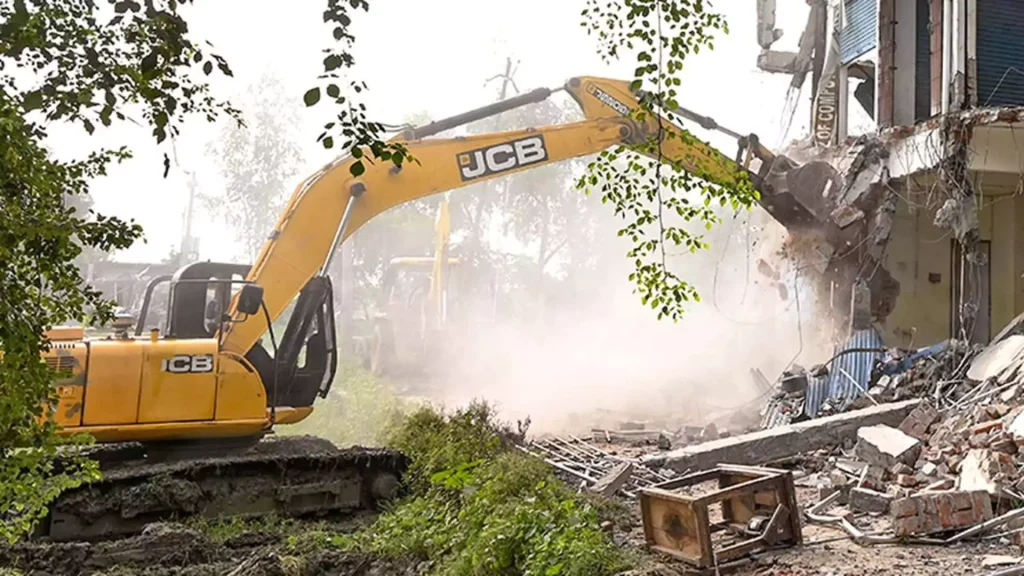Context:
Recently, the Supreme Court laid down a series of guidelines to ensure that due process is followed for demolishing the properties of citizens.
More on News:
- Under the power of Article 142 of the Constitution, the Supreme Court in the ‘Demolition of Structures vs Ors Case’ laid down a series of guidelines to ensure ‘due process of law’ is followed for demolishing the properties of citizens.
- These guidelines were a part of the court’s verdict in a case that had raised the issue of demolition of properties by state authorities as a punishment for the alleged involvement of the property owner in a crime.
- The case pertained to a set of pleas that challenged the “extra-legal” practice of demolishing houses of people accused of criminal activities.
Case Background:
- Controversial Practice: The issue of arbitrary property demolitions, often referred to as “bulldozer justice,” involves demolitions carried out as punitive actions against individuals accused of criminal activities.
- Bulldozer Justice: It refers to the practice of using bulldozers/heavy machinery to demolish properties of individuals accused of crimes (often without due process of law). This leads to punitive action by the state which bypasses procedural and judicial safeguards.
- Incidents Across States: This practice has been observed in states like Uttar Pradesh, Madhya Pradesh, Uttarakhand, and Rajasthan, with homes of accused individuals being razed without due legal process.
- Communal Tensions: In many cases, demolitions followed communal violence or protests, sparking debates over fairness and legality. For example, properties were destroyed after violence in Delhi’s Jahangirpuri in 2022 and Prayagraj in Uttar Pradesh.
- Legal Challenges: Several petitions were filed, including one by Jamiat-Ulama-i-Hind, raising concerns over the extrajudicial nature of such demolitions and their violation of constitutional rights.
- Note: Article 142 of the Constitution: It empowers the Supreme Court to pass any decree or order necessary for doing complete justice in any case or matter pending before it.
Supreme Court Guidelines:
- Notice Requirements: Authorities must provide a minimum 15-day notice period before any demolition, with the notice containing detailed information about the structure and reasons for demolition.
- Documentation Protocol: The notice must be served through registered post and affixed to the outer portion of the structure, with immediate email notification to the local Collector or District Magistrate.
- Administrative Responsibility: Collectors and District Magistrates must appoint dedicated nodal officers to oversee demolition processes.
- Hearing Process: Personal hearings are mandatory, with proper recording of minutes and detailed documentation of proceedings.
- Order Specifications: Final demolition orders must include comprehensive information about arguments presented, justification for demolition, and explanation of why demolition is the only viable option.
- Implementation Timeline: A 15-day grace period must be provided after the final order to allow property owners to either remove the construction or challenge the order legally.
- Video Documentation: All demolition proceedings must be videographed and preserved, with detailed inspection and demolition reports.
- Accountability Measures: Violation of these guidelines can lead to contempt proceedings against responsible authorities.
- Structural Assessment: Authorities must determine if unauthorized structures are compoundable and justify why complete demolition is necessary.
- Protection of Rights: The executive cannot declare an accused guilty and demolish their house without proper judicial process.
Exceptions to Guidelines:
- Public Spaces: Guidelines do not apply to unauthorized structures in public places like roads, streets, or footpaths.
- Railway Property: Structures abutting railway lines are exempt from these guidelines.
- Water Bodies: Construction near rivers or water bodies falls outside the purview of these guidelines.
- Court Orders: Cases where demolition orders are issued by courts of law are exempt from these guidelines.
Rationale Behind the Guidelines:
- Constitutional Protection: The guidelines aim to protect fundamental rights, particularly the ‘right to shelter’ under Article 21 of the Constitution.
- Separation of Powers: The Court emphasizes that executive authorities cannot assume judicial functions and determine guilt or punishment.
- Humanitarian Concerns: The Court acknowledges the impact on vulnerable sections, noting it is “not a happy sight” to see women, children, and ailing persons displaced.
- Transparency Requirements: Guidelines ensure government actions are transparent and officials are held accountable for their decisions.
Challenges in Implementation:
- Administrative Resistance: Local authorities may face difficulties adapting to new procedural requirements and timeline constraints.
- Resource Allocation: Implementation of video documentation and proper notice serving mechanisms requires additional resources and infrastructure.
- Monitoring Mechanism: Ensuring compliance across different states and municipalities poses significant coordination challenges.
- Legal Awareness: Property owners need to be educated about their rights and the new procedural safeguards available to them.
Way Forward:
- Technology Integration: Implementing digital systems for documentation, notification, and monitoring of demolition processes.
- Capacity Building: Training programs for officials to ensure proper understanding and implementation of guidelines.
- Public Awareness: Conducting awareness campaigns to inform citizens about their rights and the new procedural safeguards.
- Grievance Redressal: Establishing effective mechanisms to address complaints about violations of these guidelines.
- Monitoring Framework: Developing systems to track compliance and identify patterns of violations across different regions.

